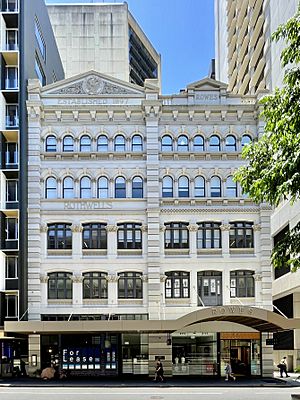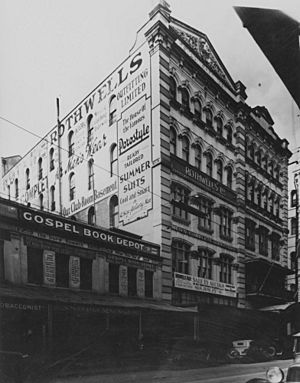Rothwells Building facts for kids
Quick facts for kids Rothwells Building |
|
|---|---|

Rothwells Building (left, straight awning) and Rowes Building (right, arched awning), 2021
|
|
| Location | 237 Edward Street, Brisbane City, City of Brisbane, Queensland, Australia |
| Design period | 1870s - 1890s (late 19th century) |
| Built | 1885 - 1909 |
| Architectural style(s) | Classicism |
| Official name: Rothwells Building | |
| Type | state heritage (built) |
| Designated | 21 October 1992 |
| Reference no. | 600094 |
| Significant period | 1885, 1909 (fabric) |
| Builders | W Macfarlane |
| Lua error in Module:Location_map at line 420: attempt to index field 'wikibase' (a nil value). | |
The Rothwells Building is a historic commercial building located at 237 Edward Street in Brisbane City, Queensland, Australia. It was built between 1885 and 1909 by W Macfarlane. This building is so important that it was added to the Queensland Heritage Register on 21 October 1992, meaning it's protected for future generations to see.
Contents
The Building's Story
The Rothwells Building was built in 1885. It was constructed at the same time as the building next door, called the Rowes Building. These two buildings were built together for their owners, John Forsyth and Thomas MacDonald-Paterson. John Forsyth was a local businessman who bought and sold goods. Thomas MacDonald-Paterson was a lawyer and also a Member of Parliament, meaning he helped make laws for the state.
Building both structures cost a lot of money, about £13,000 back then. The main builder for the project was W Macfarlane. The ground floor of the Rothwells Building was planned for offices. The other floors could be used for more offices or for storing goods (warehousing).
Changes Over Time
In January 1887, John Forsyth rented his part of the building to a company called Carew, Gardner and Billington Limited. This company sold fabrics and clothing. They bought the building in 1896. Later, in December 1904, they rented it out to Rothwells Ltd.
Rothwells Ltd was a company that sold clothing and offered tailoring services. They started their business in 1897. In 1909, Rothwells Ltd bought the building for £9,000. That same year, in January 1909, a fire damaged four floors of the building, which was then known as Rothwells Chambers. The damaged parts of the building had to be rebuilt.
More changes happened inside the building between 1957 and 1958, when it was renovated. In the early 1980s, the building went through big changes again. This was part of a larger project to redevelop the area, including the nearby Rowes Building. Today, the Rothwells Building has a pub, a shopping area, and offices.
What the Building Looks Like
The Rothwells Building is a five-story building made of stone, with a basement underneath. The front of the building, which faces the street, has a classic design. It uses styles that were popular in the late 1800s.
Special Design Features
The lower floors have wide, curved openings, like big arches. These arches are framed by decorative columns. These columns have fancy tops called capitals. The windows also have curved frames around them, called architraves, with special wedge-shaped stones at the top, known as keystones.
At the very top of the building, there's a decorative border called a cornice. This cornice is held up by brackets. Above this, there's a fancy triangular shape called a pediment. This pediment stretches across the whole width of the building. On it, you can read the words ROTHWELL'S - ESTABLISHED 1897.
Inside, the Rothwells Building is connected to the Rowes Building next door. They share some services. Most of the inside has modern suspended ceilings and office walls. The Rothwells Building's design is very similar to the Rowes Building, making them look like a pair.
Why It's a Heritage Site
The Rothwells Building was added to the Queensland Heritage Register on 21 October 1992. This means it's considered very important because of its history and design.
Important History
The Rothwells Building helps us understand how Queensland's history has changed over time. It shows us what a commercial building from the 1880s looked like, especially with its detailed and fancy front.
Beautiful Design
The building is also important because of its beautiful look. People in the community value its fine, classic design. Its shape, the materials it's made from, and its size all make Edward Street look much better. It stands out as a great example of old architecture.


